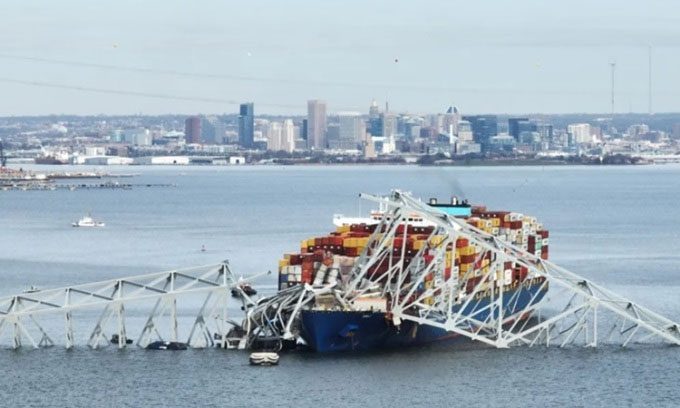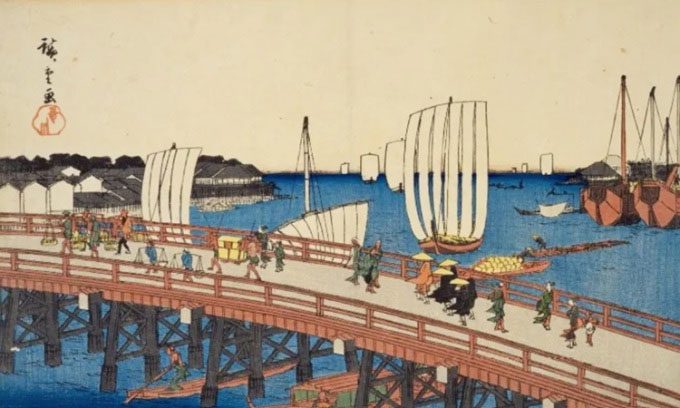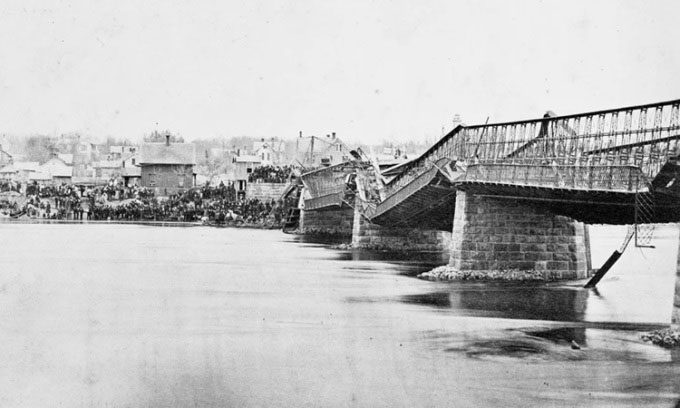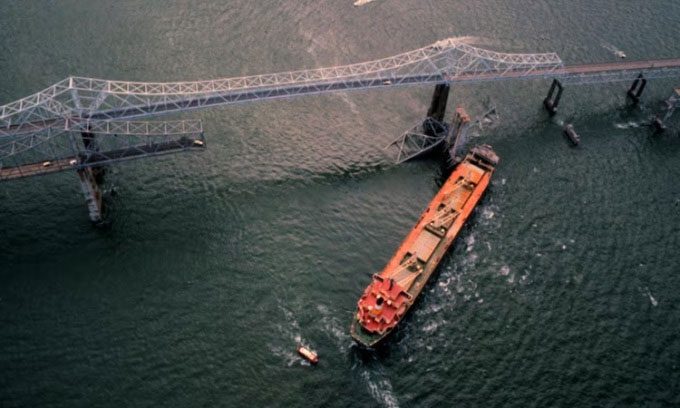Many bridge collapse disasters around the world result from diverse causes, ranging from design flaws to extreme weather and human error.
Shortly after 1 PM on March 26, the crew of the Dali, a cargo ship en route to Sri Lanka, sent an emergency signal, warning authorities that the ship had lost power. Minutes later, the Dali collided with the Francis Scott Key Bridge in Baltimore, causing the 47-year-old structure to collapse into the Patapsco River, resulting in six deaths from falling into the water.
The ship struck a support pillar before catching fire with the surrounding bridges collapsing. The incident occurred in an instant, triggering a chain reaction collapse, in which “damage to one structural component led to damage to adjacent components, unable to withstand the new loads placed above,” according to Andrew Barr, an engineer at the University of Sheffield in the UK.

The steel frame of the Francis Scott Key Bridge collapsed onto the container ship during the bridge collapse on March 26. (Photo: AFP).
This structure is a continuous truss bridge, meaning it consists of a steel truss extending over three main spans. Although the bridge contractor implemented protective measures to prevent structural damage, the size and force of the Dali quickly overwhelmed these safety measures. The bridge, built in 1977, may not have been equipped to handle the scale of modern maritime traffic, according to Toby Mottram, a retired engineer at the University of Warwick, UK.
While authorities began investigating the cause of the accident and assessing the economic damage, many uncertainties remained. Although the accident caused significant damage, it was not the first time such an event occurred. From 1960 to 2015, 35 major bridges worldwide collapsed due to collisions with ships or barges, resulting in 342 fatalities, according to a 2018 study. Throughout history, there have been numerous examples of bridge collapses, with various causes.
1. Eitaibashi Bridge in Japan, 1807

The wooden Eitaibashi Bridge as depicted in a newspaper. (Photo: British Museum).
Constructed in the late 17th century, the Eitaibashi Bridge spanned the Sumidagawa River in Edo (now Tokyo). In 1807, a crowd surged towards a local festival held on the bridge, causing it to collapse under the weight of revelers. A total of 1,400 people died in the disaster.
Eventually, the bridge was rebuilt, but the new structure was not much better than the previous version. In 1923, the Kanto earthquake struck Tokyo, killing over 140,000 people and causing fires that devastated much of the city. The Eitaibashi Bridge was also among the structures destroyed by the natural disaster.
2. Ponte das Barcas Bridge in Portugal, 1809
On March 29, 1809, under the command of Napoleon Bonaparte, the French army invaded the Portuguese city of Porto. Local residents panicked and attempted to flee across the Ponte das Barcas, a pontoon bridge constructed in 1806 from 20 boats connected by steel cables.
“The young and old, men and women, rushed forward in utter chaos, some were already on the bridge, while others tried to climb on in a frenzied state,” historian W.F.P. Napier described in 1838. Overloaded by residents and Portuguese soldiers, the bridge collapsed, sending thousands into the Douro River. The exact death toll remains uncertain, but contemporary scholars have suggested the figure of 4,000 is somewhat exaggerated.
3. The Dixon Bridge Disaster in Illinois, USA, 1873

The Dixon Bridge after the collapse. (Photo: Wikimedia).
After a series of wooden bridges spanning the Rock River in Illinois deteriorated, local residents eagerly planned for an iron bridge. In 1868, the Dixon City Council decided to proceed with a design by Lucius E. Truesdell, ignoring warnings from engineers about serious design flaws. The bridge was inaugurated in January of the following year, just weeks after another bridge designed by Truesdell collapsed in Elgin, though it did not result in any fatalities.
Four years later, on May 4, 1873, tragedy struck during a baptism ceremony on the river organized by Reverend J.H. Pratt. According to the Chicago Tribune, as the third person stepped up to receive the sacrament, the bridge suddenly collapsed, causing nearly 200 people and six horses on it to fall into the Rock River from a height of about 18 feet. Some drowned, while others died before even touching the water. Some were caught in debris, while others jumped from the bridge into the river and swam to safety. The bridge collapse ultimately claimed 46 lives and injured 56 others. Scientific American concluded that the Truesdell bridge disaster resulted from flawed engineering theories, poor materials, and insufficient construction practices.
4. Quebec Bridge in Canada, 1907 and 1916
The Quebec Bridge in Canada collapsed not once, but twice before its official opening. The construction of the cantilever bridge, among the longest in the world, began in 1900. Before the first disaster, workers noticed that main structural components of the bridge were deforming, but authorities deemed the issue not serious enough to halt construction. Then, on the afternoon of August 30, 1907, a section of the bridge collapsed, narrowly missing a passing steamship. Of the 86 workers on the bridge at the time, only 11 survived. An investigation blamed the bridge engineers.
After the disaster, the government responsible for the project commissioned a complete redesign of the bridge. This time, the accident occurred at the end of the construction process when workers attempted to raise the central span into position in front of a crowd of tens of thousands on September 11, 1916. The lifting operation failed, resulting in 13 fatalities. Ultimately, the bridge was opened to traffic in 1917 and remains in use today.
5. Tacoma Narrows Bridge in Washington, USA, 1940
Nicknamed “Galloping Gertie” for its tendency to bounce vertically on windy days, the Tacoma Narrows Bridge collapsed on November 7, 1940, just four months after its opening. That morning, as wind speeds reached 40 mph, the suspension bridge began to twist horizontally, leaning 28 feet at a 45-degree angle, according to the Washington State Department of Transportation.
By midday, the 1,000-foot-long approaches at both ends of the massive structure began to disintegrate and fall apart. Local reporter Leonard Coatsworth was the last person on the bridge. He escaped by climbing out of his car window and crawling 1,500 feet on hands and knees. The bridge collapsed shortly after.
6. Silver Bridge in West Virginia and Ohio, USA, 1967
The deadliest bridge collapse in modern history prompted the United States to adopt new safety measures. This suspension bridge, which led to these changes, opened over the Ohio River in 1928, linking West Virginia and Ohio. Officially named the Point Pleasant Bridge, it is widely known as the Silver Bridge due to its aluminum color.
At around 5 PM on December 15, 1967, the bridge collapsed, initially tipping slowly from the Ohio side, then folding towards West Virginia, according to eyewitness accounts. 32 vehicles fell into the water, and 46 people died. Investigators later determined that a small crack in one of the bridge’s suspension rods (a straight metal rod with holes, also known as “eyes” at both ends) caused the collapse. The crack was undetectable by the naked eye and could only have been addressed by dismantling the suspension rod, an impossible task, according to the West Virginia Department of Transportation.
7. Sunshine Skyway Bridge in Florida, USA, 1980

The Sunshine Skyway Bridge collapse viewed from above. (Photo: Tampa Bay Times).
The Sunshine Skyway Bridge in Florida may be the most similar example to the Francis Scott Key Bridge on this list. On May 9, 1980, the cargo ship M.V. Summit Venture collided with a support girder of the bridge during a severe thunderstorm, causing a 1,200-foot section to fall into Tampa Bay. Six cars, one truck, and one bus plunged into the water, resulting in 35 fatalities.
Bruce Atkins, a crew member on the cargo ship, reported that the thunderstorm came up suddenly with winds that obscured visibility. At that moment, they were unaware that the wind was causing the ship to change course. Investigators later cleared the cargo ship’s captain, John Lerro, of any wrongdoing.
A replacement bridge was opened over Tampa Bay in 1987. To prevent similar tragedies in the future, engineers raised the height of the structure and widened the channel below. Authorities also placed concrete islands as underwater barriers around the bridge. Designed to withstand loads of 30 million pounds, the barriers help protect the bridge by redirecting approaching vessels.


















































